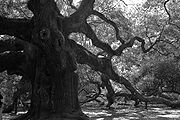
Angel Oak
Encyclopedia
The Angel Oak is a Southern live oak
tree located in Angel Oak Park, in Charleston, South Carolina
, on Johns Island
, one of South Carolina's Sea Islands
. It is estimated to be in excess of 1500 years old, stands 65 ft (19.8 m) tall, measures 28 ft (8.5 m) in circumference, and shades with its crown an area of 17000 square feet (1,579.4 m²). Its widest crown spread point-to-point is 180 ft, which is longer than any other live oak in the country. Its longest limb is 105 feet (32 m) in length. The tree and surrounding park have been owned by the city of Charleston since 1991.
. Angel Oak stands on part of Abraham Waight's 1717 land grant. The oak derives its name from the Angel estate, although local folklore told stories of ghosts of former slaves would appear as angel
s around the tree. The tree has become a significant tourist attraction.
It has survived countless hurricanes, floods, earthquakes, and human interference. Angel Oak was damaged severely during Hurricane Hugo
in 1989 but has since recovered.
Acorns from the Angel Oak have grown to produce authentic direct-offspring trees. Live oaks generally remain short in proportion to their outward growth.

Southern live oak
Quercus virginiana, also known as the southern live oak, is a normally evergreen oak tree native to the southeastern United States. Though many other species are loosely called live oak, the southern live oak is particularly iconic of the Old South....
tree located in Angel Oak Park, in Charleston, South Carolina
Charleston, South Carolina
Charleston is the second largest city in the U.S. state of South Carolina. It was made the county seat of Charleston County in 1901 when Charleston County was founded. The city's original name was Charles Towne in 1670, and it moved to its present location from a location on the west bank of the...
, on Johns Island
Johns Island, South Carolina
Johns Island, also spelled John's Island, is the largest island in the U.S. State of South Carolina. It is one of the many Sea Islands along the coast of South Carolina.-Background:...
, one of South Carolina's Sea Islands
Sea Islands
The Sea Islands are a chain of tidal and barrier islands on the Atlantic Ocean coast of the United States. They number over 100, and are located between the mouths of the Santee and St. Johns Rivers along the coast of the U.S...
. It is estimated to be in excess of 1500 years old, stands 65 ft (19.8 m) tall, measures 28 ft (8.5 m) in circumference, and shades with its crown an area of 17000 square feet (1,579.4 m²). Its widest crown spread point-to-point is 180 ft, which is longer than any other live oak in the country. Its longest limb is 105 feet (32 m) in length. The tree and surrounding park have been owned by the city of Charleston since 1991.
Cultural significance
The Angel Oak is thought to be one of the oldest living organisms east of the Mississippi RiverMississippi River
The Mississippi River is the largest river system in North America. Flowing entirely in the United States, this river rises in western Minnesota and meanders slowly southwards for to the Mississippi River Delta at the Gulf of Mexico. With its many tributaries, the Mississippi's watershed drains...
. Angel Oak stands on part of Abraham Waight's 1717 land grant. The oak derives its name from the Angel estate, although local folklore told stories of ghosts of former slaves would appear as angel
Angel
Angels are mythical beings often depicted as messengers of God in the Hebrew and Christian Bibles along with the Quran. The English word angel is derived from the Greek ἄγγελος, a translation of in the Hebrew Bible ; a similar term, ملائكة , is used in the Qur'an...
s around the tree. The tree has become a significant tourist attraction.
It has survived countless hurricanes, floods, earthquakes, and human interference. Angel Oak was damaged severely during Hurricane Hugo
Hurricane Hugo
Hurricane Hugo was a classical, destructive and rare Cape Verde-type hurricane which struck the Caribbean islands of Guadeloupe, Montserrat, St. Croix, Puerto Rico and the USA mainland in South Carolina as a Category 4 hurricane during September of the 1989 Atlantic hurricane season...
in 1989 but has since recovered.
Acorns from the Angel Oak have grown to produce authentic direct-offspring trees. Live oaks generally remain short in proportion to their outward growth.


